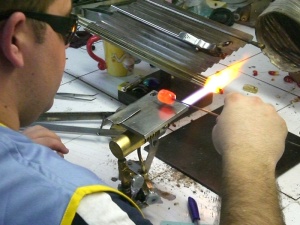Where did all these glass craft-work techniques originate? To put it simply, Venetian master glass-makers learned a lot from the glass workmanship techniques used in Asia. They didn’t just copy those techniques, they developed and molded them according to their personal tastes and their abilities. It was then that Murano glass as we know it, came to be. It is a wise meeting point between Oriental techniques and Italian imagination and creativity.
Murano Master glass-makers contributed, for example, to the use of different colors and the creation of items distinguished by one unique characteristic: style. Murano glass is perfect for artistic hand crafting: it is in fact a material that is extremely malleable while crafted at high temperatures. Venetian artists were then able to create the shapes and colors that dictated its world wide success.
Through the centuries, Venice developed sophisticated techniques to forge and mold glass. So much that in the fourth century the names of Venice and Murano became synonymous of high quality artistic glass. But why did Murano, of all places, become the location for this hand crafted artistry? The reason is simple: many glass workshops rose on the Island of Murano and in 1291 Venice decided to dismantle all the other glass workshops in the city – to minimize fire danger – leaving to Murano the privilege of becoming the only island where glass would be made and crafted. This is why we have been calling it Murano glass and not just Venetian glass for the last thousand years.
During the Renaissance, the artistry of master glass-makers was already well known. Murano glass was so renown that it was sought after by popes, kings and court nobles. In other words: the richest people chose the only glass that would really emphasize their wealthy status, which was the one that was made in Murano. A specialised school rose on the island and the art of glass crafting was passed on from generation to generation.
In the Seventeen hundreds the Republic of Venice was declining – its end is dated 1797 – but Murano glass was untouched by the crisis. Actually, there was a little decrease in demand but in the second half of the Eighteen hundreds this art was rediscovered and Venetian masters started being appreciated again. Quickly their jewelry and decor in murrina glass are again a symbol of elegance, prestige, finesse and design.
The centuries passed and Murano artisans still use those centuries old techniques of murrina crafting.They use them for everything: from contemporary glass art to Murano glass figurines, chandeliers and jewelry. Today Murano is where many workshops and single artists’ laboratories are located, they craft all sorts of items from those intended for mass marketing to the eccentric glass masterpieces.
What is remarkable is that still today, Murano is an expression of true art. Venetian artisans devote their passion to glass artistry, they are unwilling to serial mass produce and still use antique furnaces. This implies that every glass object made in Murano has its own unique and unrepeatable beauty that is unreproducible by any other master Venetian glass-maker. Mass production never reached Murano and everything remains at a hand crafting level as it was a thousand years ago.

